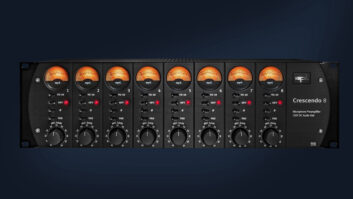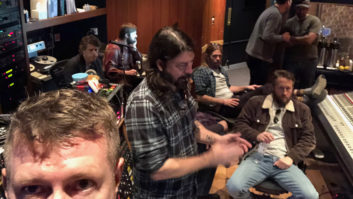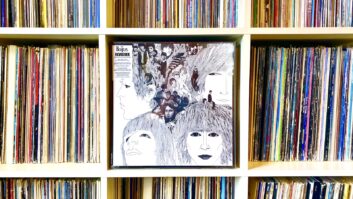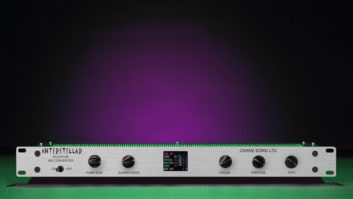Move beyond the tired arguments as to whether analog recordings sound better than digital, and you’ll find few engineers who will contest the tremendous flexibility, ease and speed that recording to a digital audio workstation (DAW) affords.
The benefits of tracking to a DAW are perhaps no more compelling than when recording vocals. After capturing several takes, a composite lead vocal and background choruses can be quickly assembled in a drag-and-drop jiffy. Ear-bending vocal lines can be auto-tuned to sweet perfection in a snap. And, an untrained singer’s wildly fluctuating dynamics can be readily reined in by plug-ins such as Waves’ C4 Multiband Parametric Processor or the frequency-morphing Arboretum Systems’ Ionizer.
With all of this power available to the digital devotee, the question becomes how much should you process the vocal performance before it hits your A/D converter vs. afterward? Here’s a hint: If the ubiquitous DAW is the solution to all production needs, trade shows wouldn’t be filled to the gills with analog outboard gear. But they are.
Mixinterviewed three top-drawer engineers — Marc DeSisto, Sylvia Massy Shivy and Dave Ogilvie — to learn how they record vocals to DAWs, and chat about signal processing and engineering techniques on both sides of the A/D. (See “Workstation Wizards” for their credits.) In some respects, tracking vocals to a DAW motivates profound changes in the way these engineers workvis a visworking with analog tape. In other ways, it makes little or no difference at all.
THE SONG REMAINS THE SAME
Whether committing vocals to an analog or digital medium, Ogilvie says that his choice of microphones has never really changed. “My standards are Shure SM7 and SM58s, AKG 414-TLII and C12, and [Neumann] U47s.”
That said, Ogilvie notes that “the SM7 gets more action out of plug-ins. That is, when you start playing around with plug-ins [on a vocal track recorded with an SM7], the effect seems to be more extreme. The SM7 is kind of a narrow-band mic, so the vocal really comes through quite easily in a mix without having to work as much to bring it out. I end up using the SM7 and SM58 quite a bit in the industrial rock world.”
Massy Shivy’s tastes in vocal microphones are equally eclectic, ranging from the tube U47 to the AKG C 1000 and Shure SM58.
With the exception of the Neumann M149, DeSisto turns to vintage mics — citing the FET 47, Telefunken 251 and Neumann U67 — to “round off [the sound] a bit before it gets to Pro Tools.” DeSisto’s focus while tracking vocals is largely on getting a unique and striking sound vs. something more transparent. “I own a Universal Audio 2610 mic pre because it actually has a sound,” he remarks. “It’s really wonderful. I don’t want to buy something that’s transparent because, it’s like, ‘Okay, what is it doing?’ I like something that actually has a sound.”
Massy Shivy and Ogilvie have similar tastes in mic pre’s. Massy Shivy gravitates toward using “older Neve mic preamps” and, occasionally, the Telefunken V72. For recording loud rock vocals, Ogilvie specifically likes the Neve 1063 and 1081 mic preamps, in part because of their versatility. “If I want more or less distortion,” he says, “one step on the Neve [gain control] is almost like a completely different picture.”
COLOR MY WORLD
All three of the engineers interviewed prefer to use analog rather than digital EQ on vocal tracks. “[Analog EQ] gives it a little better color,” Ogilvie asserts. Massy Shivy finds that “digital EQs allow you to pinpoint certain frequencies if you’re trying to repair a track, but I always go for the analog EQ, whether it’s a [Neve] 1073 or a 1081. I like the tonality and the simplicity.” DeSisto relies on his Pultec or analog console for EQ duties.
Although they all generally shun using a DAW’s EQ plug-ins on vocals, they differ as to how much analog EQ they’re likely to use while tracking. DeSisto doesn’t like to use a lot of EQ when recording vocals because it makes it hard to match up vocal punch-ins later on in the process. He’ll typically use a Pultec to “attenuate maybe 20 or 30 cycles a little bit to pull out the rumble that’s in the room, so that the [downstream] compressor isn’t seeing any of that low-end stuff. And I might boost a little [with shelving EQ] at 10 kHz.” If the singer wants to hear his/her vocals sound exceedingly bright, DeSisto will simply add EQ in their headphone feed only.
Massy Shivy is less reserved when adding EQ to DAW-bound vocals. “I’ll definitely EQ [before hitting the computer],” she states emphatically. “I’ll make sure it has enough richness and isn’t too thin. I’ll typically add a bit of lower mid and some sizzle on top. I prefer to have everything recorded as close to the sound I’ll want at mixdown so that while we’re monitoring during recording, we’re hearing as much of the final picture as possible. I don’t want to wait until the mix to find that sound. I like to record it initially.”
If Massy Shivy’s motto is “damn the torpedoes,” then Ogilvie’s is “hold your fire!” “To get the sound I want on vocals,” he says, “I rely on the combination of the mic, the preamp and the compressor, and I try to avoid EQ. I don’t EQ going into the computer ever. I will a bit on the end, but it will generally be in the analog domain [with an analog console at mixdown].”
“I’m really not a fan of EQ’ing the hell out of vocals,” Ogilvie continues, “because I find it changes a lot of things that you didn’t want it to change. Also, the singer is adapting to what they’re hearing, so they’re almost singing along with how it’s being processed. If you change the track afterward with radical EQ, all of a sudden, it’s almost like a different performance. The processing I would do on it later would likely be compression and [time-based] effects, as opposed to EQ.”
PUT A LID ON IT
Though our interviewees had disparate preferences for when and how much to EQ vocals, they were virtually in harmonic convergence on the subject of when to compress. They all voiced a strong predilection to using analog compressors on vocals before they reach the DAW.
“I’ll do quite a bit of compression before I go in [the computer],” Ogilvie notes. “I’ll do as much as I can to get it as hot in to the digital realm without any clipping whatsoever.” Ogilvie usually turns to a vintage LA-2A, Fairchild 670 or an outboard SSL compressor (the rackmounted version of the master-bus compressor) for vocal dynamics processing. For more extreme compression, he regularly calls on the Empirical Labs Distressor.
DeSisto also always used compression when tracking vocals to a DAW, preferring to use a Fairchild, a Distressor, an 1176 or an LA-2A. He notes that he can compress a vocal, say, 10 dB with a vintage LA-2A, “and it’s just fine. It’s okay, don’t worry, f*** the meter. We’re in this to listen. Always use your ears, always trust what you’re hearing.”
Ogilvie agrees, adding, “If you’re listening to it super-loud over the mix, you might hear it and go, ‘Whoa, it’s too much.’ But then when you set it back in its proper perspective, it could be right on.”
Massy Shivy uses two compressors chained in series: “I like to use an RCA BA6A, followed by an 1176. The BA6A is big and soft, and the 1176 tightens it up. I’m not afraid to slam it. I’ll go for approximately a 8:1 ratio on the RCA and then up to an even 20:1 on the 1176 to really hold it down and bring up the quiet parts. I don’t do that all of the time, but the point is, I’m not afraid of compression.”
The use of high compression ratios while tracking can be risky. DeSisto notes that if a singer doesn’t know how to work the mic, they might slam the compressor too hard by singing too loudly while in close proximity to the mic. His solution is to patch the compressor into the signal path after the fader (i.e., on the bus’ output). That way, he can ride the fader down during loud phrases to avoid it triggering the compressor too heavily and squashing the sound.
“There are some parts where you don’t want to compress at all,” DeSisto explains. “If the singer is really close to the mic, I’m bringing the fader down. I make marks on a little piece of tape next to the fader. I make a verse mark, maybe a B-section mark and a chorus mark. And then there are all of these subtle things in between those marks where I’m scooping. After the [vocal is tracked], I can just leave the fader alone and a lot of my rides are already done.”
NOW I KNOW MY ADCS
Once a vocal track sounds great, it’s time to get it in to the computer. Interestingly, none of these engineers routinely record at the higher sampling rates available on current-model ADCs, preferring to work at 48 kHz and 24 bits. Ogilvie admits that 96kHz digital audio sounds compelling, but “staying at 48 kHz is probably safer at this time. If someone somewhere down the line doesn’t have access to the proper [96kHz-capable] equipment, then you’re getting into trouble. Also, I must say that although the stuff I have done at 96 kHz sounds great, I don’t know how much of a difference it really makes for the style of music I mostly do.” Ogilvie prefers to work at 48kHz sampling rate instead of 44.1 kHz because the ADC’s filters are placed further out of harm’s way at the higher rate.
A big fan of Apogee AD8000SE and PSX-100 converters, Ogilvie opts to keep the Soft Limit function for those units turned on. “There’s nothing worse than getting a great performance ruined [by digital overs],” Ogilvie explains. “I’m willing to sacrifice what Soft Limit does in exchange for protection.” He uses the Digidesign 192 Digital I/O to bus digitized tracks into either a Pro Tools|HD system or into Logic Audio, because Logic has the ability to automate multiple plug-ins easily. “If you tried that in Pro Tools, there’s no way [it would work],” he asserts.
DeSisto is also a fan of the Apogee AD8000 but prefers to turn off Soft Limit. Both he and Massy Shivy work strictly in Pro Tools; Massy Shivy typically uses the Digidesign 888 I/O as a front end for a Pro Tools MIXPlus system.
YOU MOVE ME
Once inside the computer, vocal tracks can be spruced up using the DAW’s powerful editing capabilities. This is especially helpful when dealing with background vocals.
“I just love doing vocals in digital,” Massy Shivy enthuses, “because it’s so much easier to comp. On choruses, when I double and triple and quadruple or add harmonies in a big slab, I’ll look at the waveform and make sure that all of the words start at the same time and end at the same time so that the consonants — the ‘t’s, for example — all line up. You can make those backing vocals sound so tight.”
If any consonant is not time-aligned with its iteration on another track, Massy Shivy will “chop it up and move it, and then I’ll stretch between to make up the space.” For example, if she moves a consonant later in time, she’ll then edge-edit the consonant to reveal its preceding vowel and stretch the vowel earlier along the timeline until it adjoins its original utterance. She then puts a crossfade at the seam for the elongated vowel. “Most of the time, the edit will be unnoticeable,” Massy Shivy notes. “In a block of backing vocals, any glitches are very minor.”
Not quite yet satisfied, Massy Shivy will then typically remove all but two of the background singers’ breath noises. “Instead of having six breaths all happening at once,” she says, “just having two cleans things up so much.” Once the BVs are all tight and tidy, she’ll move the entire block into every chorus.
GIVE ME A PLUG
For digital processing, it seems that DeSisto, Massy Shivy and Ogilvie all tend to return to a relatively small set of favorite plug-ins.
“I’ll stay with the Waves DeEsser, L1 [Ultramaximizer] and C4 for vocals,” Ogilvie admits, adding, “I used to use the L1 too much. It produces a distortion that I’m not as fond of as I was a couple of years ago. And with the C4, I find I can be a little more specific.”
Ogilvie uses the L1 “more like an effect. I’ll usually get it pretty slammin’. On rock music, this works great. But once when I was working with a country artist, I went for the typical way I was doing it and a week later, listening to it in the mix, I was like, ‘Oh, my God, I can’t believe what I did.’ It didn’t suit the style.”
We talked about how the C4 can control proximity effect on vocals far better than EQ, because the C4’s dynamic processing can be tweaked to let leaner vocal phrases pass through untouched. “It keeps the flavor of the vocal where you had it,” Ogilvie notes, “yet it can solve your problems. It’s also great for bringing stuff out when a vocal is lacking something.” Ogilvie is also fond of Logic Audio’s stock splitband compressor.
Massy Shivy is a big fan of Antares’ Auto-Tune, confessing she uses it “quite a bit on most projects. I’ll crush the vocal until it’s just a straight line and it sounds really robotic. I’ll also use effects in the Waves Gold Bundle for harmonizing [using Ultra-Pitch] and flanging.”
DeSisto likes to use the TDM plug-in Maxim to provide a saturation effect. He might also widen the vocal with a pitch-shift plug-in or use the Bomb Factory 1176 or Fairchild plug-ins. “The little distortion and telephone [equalization curve] type plug-ins are also awesome,” DeSisto remarks, “and they’re something that you can make happen quickly. Speed is always of the essence.”
All of our interviewees prefer to mix on analog consoles, even at the expense of the quantization distortion inherent in D/A conversion. Massy Shivy mixes on a 56-input Neve 8038 with Flying Faders because she prefers the work surface. However, she does a lot of submixing within Pro Tools before mixing on the analog board. “We’ll record any kind of crazy effects into Pro Tools and just play it back to a pair of analog channels,” she notes. “The control [offered by] panning in Pro Tools is way better than your [imprecise] panning in analog.”
Perhaps Ogilvie says it best: “I really strive to get the flavor of the vocal going into the computer and don’t try to create it afterward. Try not to do anything to it [in the computer] if you can.”
Mix contributing editor Michael Cooper owns Michael Cooper Recording in beautiful Sisters, Ore.
WORKSTATION WIZARDS
After years of recording engineering in his Boston hometown, Marc DeSisto moved west to Hollywood in 1984 and eventually wound up as a staff engineer for A&M Studios. In addition to working on U2’s Rattle and Hum (Island, 1988), while at A&M, DeSisto engineered, mixed or co-mixed a variety of projects by Don Henley, Cutting Crew, Belinda Carlisle, Suzanne Vega, Patti Smith, Amy Grant and Lone Justice. DeSisto moved on from A&M in early 1990 to work as an independent producer/engineer, and has since amassed a colorful list of rock and pop credits, including projects with Chris Isaak, Michelle Branch, Stevie Nicks, Lindsey Buckingham, Joe Cocker and Spinal Tap. DeSisto was nominated for a Grammy in 2000 for his work on Melissa Etheridge’s Breakdown (Island, 1999).
Sylvia Massy Shivy started engineering in San Francisco Bay Area studios in 1983 before moving to L.A. in 1988. She assisted at Lionshare in Hollywood in 1989 before settling in for a three-year stint as a staff engineer at Larrabee Sound in West Hollywood from 1990 to 1993. While at Larrabee, Massy Shivy produced, engineered and mixed Green Jelly’s Platinum album Cereal Killer (Zoo, 1993). Working as an independent since 1993, Massy Shivy has racked up a diverse list of credits, including projects with R.E.M., Red Hot Chili Peppers, Tool, System of a Down, Powerman 5000, Johnny Cash and Tom Petty & The Heartbreakers. Massy Shivy opened Radiostar Studios in Weed, Calif., in 2001, and now does all of her producing and engineering there. Recent projects at Radiostar include Lollipop Lust Kill, Seven Mary Three and Acroma.
Dave “Rave” Ogilvie began his recording career working as an engineer in Vancouver’s Mushroom Studios in 1984. It was his producing, engineering and mixing for Nettwerk’s industrial goth band Skinny Puppy that brought Ogilvie to the attention of Nine Inch Nails’ Trent Reznor in 1994. Reznor subsequently chose Ogilvie to co-produce and engineer Marilyn Manson’s AntiChrist Superstar (Nothing/Interscope, 1996), which went Platinum. Ogilvie has since mixed or remixed projects by David Bowie, Mötley Crüe, Killing Joke and many others. The seasoned rock producer/engineer recently finished working with Dead Relative (Island) and is currently working on Zack de la Rocha’s solo album.







